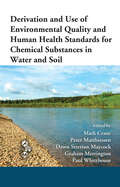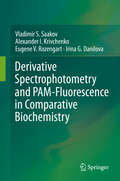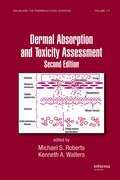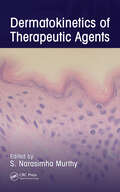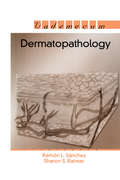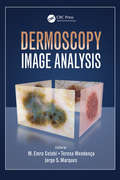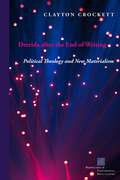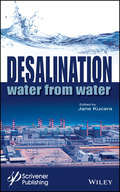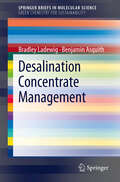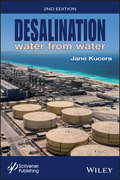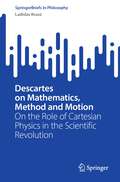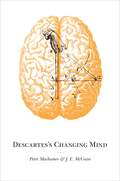- Table View
- List View
Derivation and Use of Environmental Quality and Human Health Standards for Chemical Substances in Water and Soil
by Peter Matthiessen Paul Whitehouse Mark Crane Dawn Stretton Maycock Graham MerringtonA balanced, comprehensive overview of Environmental Quality Standards (EQS), Derivation and Use of Environmental Quality and Human Health Standards for Chemical Substances in Water and Soil addresses the selection and prioritization of substances for standard derivation. With integrated content and up-to-date information on assessment of regulation
Derivative Spectrophotometry and Electron Spin Resonance (ESR) Spectroscopy for Ecological and Biological Questions
by Alexander I. Krivchenko Eugene V. Rozengart Mikhail N. Knyazev Valery Z. Drapkin Vladimir S. Saakov Yuri V. BogachevThis book provides a multidisciplinary overview to the application of high order derivative spectrophotometry and Electron Spin Resonance (ESR) spectroscopy in biology and ecology. The characteristics of the principle methods as well as the generation of reliable spectra are discussed in general terms allowing the reader to gain an idea of these methods' potentials. Furthermore the authors give an extended overview to the spectroscopic and spectro-photometric analysis of specific biological materials. This volume is a well condensed description of an analytical method and a clear review to its application in biology and related fields and an essential tool for researchers who are new in the field of spectroscopic methods and their applications in the life sciences.
Derivative Spectrophotometry and PAM-Fluorescence in Comparative Biochemistry
by Alexander I. Krivchenko Eugene V. Rozengart Vladimir S. Saakov Irina G. DanilovaThis book presents various examples of how advanced fluorescence and spectroscopic analytical methods can be used in combination with computer data processing to address different biochemical questions. The main focus is on evolutionary biochemistry and the description of biochemical and metabolic issues; specifically, the use of pulse amplitude modulated fluorescence (PAM) for the functional analysis of the cellular state, as well as results obtained by means of the derivative spectroscopy method characterizing structural reorganization of a cell under the influence of external factors, are discussed. The topics presented here will be of interest to biologists, geneticists, biophysicists and biochemists, as well as experts in analytical chemistry, pharmaceutical chemistry and radio chemistry and radio activation studies with protonen and alpha-particles. It also offers a valuable resource for advanced undergraduate and graduate students in biological, physical and chemical disciplines whose work involves derivative spectrophotometry and PAM-fluorescence.
Dermal Absorption and Toxicity Assessment (Drugs and the Pharmaceutical Sciences)
by Michael S. Roberts Kenneth A. WaltersThe source Dermal Absorption and Toxicity Assessment supplies a state-of-the-art overview of the dermal absorption process, and is divided into six well organized sections. Written by internationally recognized experts in the field, this Second Edition is a complete revised and updated text, covering the wide range of methods used to assess skin ab
Dermal and Ocular Toxicology: Fundamentals and Methods
by David W. HobsonDermal and Ocular Toxicology: Fundamentals and Methods is a procedurally-oriented volume of detailed methods and practical examples discussing the dermal and ocular aspects of toxicology. The book is divided into a dermal section and an ocular section. Each section begins with a chapter on the anatomy and physiology of each organ system and then progresses to more specialized chapters discussing such topics as the toxicological pathology of each system, state-of-the-art in vitro and in vivo evaluatory procedures, statistical considerations for test design and data interpretation, and the utilization of test findings. Test methods are provided for acute dermal exposure effects, dermal hypersensitivity and photoallergy assessment, dermal and ocular 0.pharmacokinetics, skin flap and skin grafting techniques, and in vitro alternative methods. This book can be used as an instructional text or as a sourcebook for practicing toxicologists, pharmacologists, industrial hygienists, occupational health professionals, and graduate students.
Dermatokinetics of Therapeutic Agents
by S. Narasimha MurthyNovel drug delivery technologies strive to bypass challenging biological layers to elicit desired pharmacological activity. The skin, one of our key defensive barriers, allows certain topically applied substances and toxins to pass. The dermatokinetics of a drug determines the efficacy of treatment of skin disorders.Presenting the first compre
Dermatologic Ultrasound with Clinical and Histologic Correlations
by Gregor Jemec Ximena WortsmanSignificant technological advances have produced equipment that allows imaging of the skin with variable frequency ultrasound in previously unseen detail and provides a range of dynamic data that is currently unmatched by any other technology. Dermatologic Ultrasound with Clinical and Histologic Correlations is a comprehensive introduction to ultrasonography of the skin, nails, and scalp as it relates to the assessment and diagnosis of dermatologic diseases. It provides radiologists, sonographers, dermatologists, and physicians with interest in skin imaging with a concise understanding of the diagnosis of dermatologic conditions through extensive high-resolution gray scale and color Doppler ultrasound images and presents classical correlations of clinical dermatologic lesions with sonographic and histologic findings. Featuring more than 1700 images, this text-atlas provides an excellent starting point in learning about this topic. Featuring contributions from world-renowned authorities in the field of superficial ultrasound imaging, the book reviews the technical considerations relating to color Doppler ultrasound of the skin; surveys the dermatologic entities that can be visualized with ultrasound imaging, such as cutaneous tumors, inflammatory diseases, hemangiomas and vascular malformations, melanoma, nail tumors, scalp diseases and cosmetic conditions; shows common simulators of cutaneous diseases; and discusses protocols for assessing common dermatologic conditions. Inclusion of clinical overviews, tips, and pitfalls enables a better understanding of the pathologies of the disorders and the methodological approach in assessing these entities.
Dermatological and Transdermal Formulations
by Kenneth A. WaltersContaining 350 illustrations, tables, and equations and covering AAPS/FDA guidelines for the experimentation and analysis of in vivo and in vitro percutaneous absorption, this reference provides comprehensive coverage of the development, preparation, and application of topical and transdermal therapeutic systems. Recognized international experts di
Dermatologie der Katze
by Chiara Noli Silvia ColomboDieses reich illustrierte Handbuch deckt alle Aspekte der modernen Katzendermatologie ab, von der Herangehensweise an verschiedene Anzeichen und Symptome bis hin zur Beschreibung der Ätiologie, Pathogenese, klinischen Manifestation, Diagnose und aktuellen Behandlung jeder dermatologischen Erkrankung der Katze. Daher dient dieses Handbuch als unverzichtbarer praktischer Leitfaden für den vielbeschäftigten Praktiker, um Katzen mit dermatologischen Erkrankungen schnell und sicher zu behandeln, und bietet ein aktuelles und vollständiges Nachschlagewerk für den Katzentierarzt und den Veterinärdermatologen.
Dermatology, Volume 1, 3rd Edition
by Jean L. Bolognia Julie V. Schaffer Joseph L. JorizzoDermatology, edited by world authorities Jean L. Bolognia, MD, Joseph L. Jorizzo, MD, and Julie V. Schaffer, MD, is an all-encompassing medical reference book that puts the latest practices in dermatologic diagnosis and treatment at your fingertips. It delivers more comprehensive coverage of basic science, clinical practice, pediatric dermatology, and dermatologic surgery than you'll find in any other source. Whether you're a resident or an experienced practitioner, you'll have the in-depth, expert, up-to-the-minute answers you need to overcome any challenge you face in practice. Get regular content updates, download illustrations in JPEG or PPT format, and search the complete contents online with on-the-go access at expertconsult. com. Find answers fast with a highly user-friendly, "easy-in-easy-out" format and a wealth of tables and algorithms for instant visual comprehension. Get full exposure to core knowledge with coverage of dermatology's entire spectrum of subspecialties. See just the essential information with "need-to-know" basic science information and key references. Expedite decision making and clarify complex concepts with logical tables, digestible artwork, and easy-to-grasp schematics. Visualize more of the conditions you see in practice with over 3500 illustrations, of which over 1,400 are new: 1,039 clinical images, 398 pathology slides, and 152 schematics. Stay at the forefront of your field with updated treatment methods throughout, as well as an increased focus on patients with skin of color. Get an enhanced understanding of the foundations of dermatology in pathology, the clinical setting, and dermoscopy with a completely rewritten introductory chapter. Better comprehend the clinical-pathological relationship of skin disease with increased histologic coverage. Bolognia's Dermatology is the ultimate multimedia reference for residents in training AND the experienced practitioner.
Dermatology, Volume 2
by Jean BologniaDermatology, edited by world authorities Jean L. Bolognia, MD, Joseph L. Jorizzo, MD, and Julie V. Schaffer, MD, is an all-encompassing medical reference book that puts the latest practices in dermatologic diagnosis and treatment at your fingertips. It delivers more comprehensive coverage of basic science, clinical practice, pediatric dermatology, and dermatologic surgery than you ll find in any other source. Whether you re a resident or an experienced practitioner, you ll have the in-depth, expert, up-to-the-minute answers you need to overcome any challenge you face in practice. Find answers fast with a highly user-friendly, "easy-in-easy-out" format and a wealth of tables and algorithms for instant visual comprehension. Get full exposure to core knowledge with coverage of dermatology s entire spectrum of subspecialties. See just the essential information with "need-to-know" basic science information and key references. Expedite decision making and clarify complex concepts with logical tables, digestible artwork, and easy-to-grasp schematics. Visualize more of the conditions you see in practice with over 3500 illustrations, of which over 1,400 are new: 1,039 clinical images, 398 pathology slides, and 152 schematics. Stay at the forefront of your field with updated treatment methods throughout, as well as an increased focus on patients with skin of color. Get an enhanced understanding of the foundations of dermatology in pathology, the clinical setting, and dermoscopy with a completely rewritten introductory chapter. Better comprehend the clinical-pathological relationship of skin disease with increased histologic coverage. Bolognia s Dermatology is the ultimate multimedia reference for residents in training AND the experienced practitioner. "
Dermatopathology
by Ramon L. Sanchez Sharon S. Raimer"...a worthwhile investment for... pathologists-in-training, dematologists-in-training, or medical students..." --Arch DermatologyIntended for use as a practical manual, the information in this book has been presented so as to yield a differential diagnosis for each histological finding. With some 500 entities described, the contents of this handbo
Dermatophytes and Dermatophytoses
by Jean-Philippe Bouchara Pietro Nenoff Aditya K. Gupta Vishnu ChaturvediThis book provides a comprehensive overview on the most recent knowledge in dermatophytic infection biology. Topics covered range from taxonomy, biology and genetics of most common skin disease causing fungi over immunology of dermatophytosis to diagnosis and treatment approaches. Furthermore epidemiology of skin diseases caused by pathogenic fungi is discussed. The book is aimed at researchers and advanced students in infection biology, microbiology and dermatology.
Dermatotoxicology Methods: The Laboratory Worker's Ready Reference
by Howard I. Maibach Francis N. MarzulliThis work presents and evaluates methods employed to identify the potential of certain types of chemicals to adversely affect the skin. A variety of test methods are included such as tests for skin penetration, metabolism, irritation, the skin immune system, photo effects, skin cancer, and topical effects of retinoids and depigmenting chemicals. Tests for chemicals that affect the reproductive and nervous system are also included. Both animal and human tests that have been standardised and tests that are under development and employ animal alternatives are addressed in this book. Besides different testing methods, a rationale for accepting non-animal models and a review of some regulatory agency discussions about animal alternative tests are included.
Dermoscopy Image Analysis (Digital Imaging and Computer Vision)
by M. Emre Celebi Jorge S. Marques Teresa MendongaDermoscopy is a noninvasive skin imaging technique that uses optical magnification and either liquid immersion or cross-polarized lighting to make subsurface structures more easily visible when compared to conventional clinical images. It allows for the identification of dozens of morphological features that are particularly important in identifyin
Derrida after the End of Writing: Political Theology and New Materialism (Perspectives in Continental Philosophy)
by Clayton CrockettWhat are we to make of Jacques Derrida’s famous claim that “every other is every other,” if the other could also be an object, a stone or an elementary particle? Derrida’s philosophy is relevant not just for human ethical language and animality, but to profound developments in the physical and natural sciences, as well as ecology. Derrida After the End of Writing argues for the importance of reading Derrida’s later work from a new materialist perspective. In conversation with Heidegger, Lacan, and Deleuze, and critically engaging newer philosophies of speculative realism and object-oriented ontology, Crockett claims that Derrida was never a linguistic idealist. Furthermore, something changes in his later philosophy something that cannot be simply described as a “turn.” In Catherine Malabou’s terms, there is a shift from a motor scheme of writing to a motor scheme of plasticity. Crockett explores some of the implications of interpreting Derrida through the new materialist lens of technicity or plasticity, attending to the significance of ethics, religion, and politics in his later work. By reading Derrida from a new materialist perspective, Crockett provides fresh readings of his ideas of sovereignty, religion, responsibility, and mourning. These new readings produce fruitful engagements with the thinkers who have followed Derrida, including Malabou, Timothy Morton, John D. Caputo, and Karen Barad. Here is a new reading of Derrida that moves beyond conventional understandings of poststructuralism and deconstruction, a reading that is responsive to and critical of some of the crucial developments shaping the humanities today.
Des Canadiens à l'épreuve: Histoires d'échecs qui ont mené à la réussite
by Alex BenayAvec des chapitres rédigés par : Robert Thirsk, astronaute Erica Wiebe, championne de lutte olympique Tom Jenkins, président de la société OpenText et du Conseil national de recherches du Canada Andy Nulman, cofondateur du Festival Juste pour rire … ainsi que d’autres Canadiens au sommet de leur secteur d’activité. Que signifie « échouer »? Pour certains Canadiens ayant brillamment réussi, il s’agit d’un rite de passage, d’un tremplin vers de plus grandes réalisations, voire une belle source d’inspiration. Le parcours de ces Canadiens qui ont obtenu la médaille d’or olympique, bâti des entreprises florissantes, fait avancer la médecine est jalonné de faux pas, de nombreuses tentatives infructueuses et parfois d’échecs. Des Canadiens à l’épreuve réunit le récit de dix experts issus des secteurs privé, public, à but non lucratif et universitaire qui, tout au long de leur vie, ont vécu des échecs et lutté pour réussir. Dans cet ouvrage, ils font valoir l’argument de poids suivant : la clé de la réussite pour le Canada et les Canadiens réside dans les leçons tirées d’échecs.
Desalination
by Jane KuceraThis is the first volume to cover desalination in such depth and detail, offering engineers, technicians, and operators full coverage of the applications, economics, and expectations of what will certainly become one of the most important water-related processes on the planet. Covering thermal processes and membrane processes, this is the only volume any engineer working in desalination must have, covering both practical and theoretical issues encountered on a daily basis. Certain to be an important contribution to the water management community.
Desalination Concentrate Management
by Bradley Ladewig Benjamin AsquithThis book examines five methods used for concentrate management, namely; disposal to surface water, disposal to sewerage, deep well injection, land applications and evaporation ponds. In particular, the book focuses on the design, siting, cost, and environmental impacts of these methods. While these methods are widely practiced in a variety of settings already, there are many limitations that restrict the use of certain disposal options in particular locations.
Desalination and Water Security (Earthscan Studies in Water Resource Management)
by Chris AnastasiDesalination is to the water industry what renewables are to the electricity sector. However, unlike renewables, the former is being deployed in a quiet revolution away from public glare. This book provides a holistic view of desalination, highlighting the important role this technology can play in providing safe access to water across the globe. It describes the context for this technology to flourish in the coming decades. It discusses the pressures on freshwater resources and the key role the desalination industry plays as it moves from a good-to-have provider today to a must-have mainstream water solution in the future. The book explores the vital elements of the desalination industry, including the winning technologies and how further technological developments will reduce costs and increase deployment into new areas. It also addresses the energy used and the key environmental issues of carbon dioxide emissions and brine waste production. Using a series of country case studies, the book illustrates how desalination can supplement natural water resources in different environments and for different purposes, and how it is supporting domestic and economic activity. Providing a forward-thinking assessment, the book considers developments over the next 30 years as climate change impacts become even more apparent. This book will be of great interest to those working to alleviate water scarcity and improve water security. It will also be of interest to those in water resource management, water policy and regulation, water science, and environmental engineering.
Desalination: A National Perspective
by National Research Council of the National AcademiesThere has been an exponential increase in desalination capacity both globally and nationally since 1960, fueled in part by growing concern for local water scarcity and made possible to a great extent by a major federal investment for desalination research and development. Traditional sources of supply are increasingly expensive, unavailable, or controversial, but desalination technology offers the potential to substantially reduce water scarcity by converting the almost inexhaustible supply of seawater and the apparently vast quantities of brackish groundwater into new sources of freshwater. Desalination assesses the state of the art in relevant desalination technologies, and factors such as cost and implementation challenges. It also describes reasonable long-term goals for advancing desalination technology, posits recommendations for action and research, estimates the funding necessary to support the proposed research agenda, and identifies appropriate roles for governmental and nongovernmental entities.
Desalination: Water from Water
by Jane Kucera“Blue is the new green.” This is an all-new revised edition of a modern classic on one of the most important subjects in engineering: Water. Featuring a total revision of the initial volume, this is the most comprehensive and up-to-date coverage of the process of desalination in industrial and municipal applications, a technology that is becoming increasingly more important as more and more companies choose to “go green.” This book covers all of the processes and equipment necessary to design, operate, and troubleshoot desalination systems, from the fundamental principles of desalination technology and membranes to the much more advanced engineering principles necessary for designing a desalination system. Earlier chapters cover the basic principles, the economics of desalination, basic terms and definitions, and essential equipment. The book then goes into the thermal processes involved in desalination, such as various methods of evaporation, distillation, recompression, and multistage flash. Following that is an exhaustive discussion of the membrane processes involved in desalination, such as reverse osmosis, forward osmosis, and electrodialysis. Finally, the book concludes with a chapter on the future of these technologies and their place in industry and how they can be of use to society. This book is a must-have for anyone working in water, for engineers, technicians, scientists working in research and development, and operators. It is also useful as a textbook for graduate classes studying industrial water applications.
Desayuno con partículas: La ciencia como nunca antes se ha contado
by Francesc Miralles Sonia Fernández VidalUn excitante y revelador viaje al interior de la mente y a los orígenes de la vida a través de la física cuántica. Tienes en las manos un ensayo sobre física cuántica. Un momento, por favor. ¡Espera! No permitas que esto te asuste y sueltes el libro de golpe. ¿Aceptarías una invitación a desayunar? Si decides aventurarte a navegar entre estas páginas, descubrirás un universo tan maravilloso como desconcertante. La teoría cuántica es una de las más bellas y asombrosas de la ciencia. Las reglas que sigue son alocadas en comparación con nuestro día a día. Son antiintuitivas. Al adentrarnos en el mundo cuántico se ponen en jaque nuestras creencias sobre la realidad, y también las de nuestra realidad cotidiana. Sonia Fernández-Vidal, escritora y doctora en Física Cuántica, y Francesc Miralles, escritor y periodista, nos invitan a un divertido desayuno al que también asistirán Newton, Einstein, Heisenberg y otros célebres físicos de la historia. Entre magdalenas, tostadas, café con leche y zumos de naranja, emprenderemos un fascinante y revelador viaje a los orígenes del universo y aprenderemos para qué sirve un acelerador de partículas, qué es la partícula de Dios, cómo las cosas pueden estar en dos sitios a la vez... e incluso trataremos de comprender los misterios de la existencia.
Descartes on Mathematics, Method and Motion: On the Role of Cartesian Physics in the Scientific Revolution (SpringerBriefs in Philosophy)
by Ladislav KvaszThis book argues that Descartes’ physics was a milestone on the road to modern mathematical physics. After Newton introduced a completely different approach to mathematical description of motion, Descartes’ physics became obsolete and even difficult to comprehend. This text follows the language of Descartes and the means of which motion can be described. It argues that Descartes achieved almost everything that later Newton was able to do—to describe the motion of interacting bodies- by different (i.e. algebraic) means. This volume completely refutes the received view according to which Descartes’ physics was merely a kind of discursive natural philosophy. To make this interpretation more plausible the book follows Descartes’ ideas from his early work in mathematics, through his invention of the analytic method towards his mature physics. It shows that Descartes followed a similar heuristic pattern.The volume appeals to students and researchers; it invites the reader equippedwith minimal understanding of college mathematics to follow Descartes on his intellectual journey through the Scientific Revolution. The reader will gain a deeper understanding of the role of mathematical language in the creation of modern physics and a glimpse into the fascinating world of Descartes’ scientific thought. Several of Descartes’ philosophical ideas can be traced back to his scientific interests and thus the book elucidates the motivation behind some of Descartes’ key positions in the area of epistemology and method. In the penultimate chapter the book presents four arguments in favor of seeing Descartes as a physicist on par with Galileo and Newton.
Descartes's Changing Mind
by Peter Machamer J. E. McGuireDescartes's works are often treated as a unified, unchanging whole. But in Descartes's Changing Mind, Peter Machamer and J. E. McGuire argue that the philosopher's views, particularly in natural philosophy, actually change radically between his early and later works--and that any interpretation of Descartes must take account of these changes. The first comprehensive study of the most significant of these shifts, this book also provides a new picture of the development of Cartesian science, epistemology, and metaphysics. No changes in Descartes's thought are more significant than those that occur between the major works The World (1633) and Principles of Philosophy (1644). Often seen as two versions of the same natural philosophy, these works are in fact profoundly different, containing distinct conceptions of causality and epistemology. Machamer and McGuire trace the implications of these changes and others that follow from them, including Descartes's rejection of the method of abstraction as a means of acquiring knowledge, his insistence on the infinitude of God's power, and his claim that human knowledge is limited to that which enables us to grasp the workings of the world and develop scientific theories.
